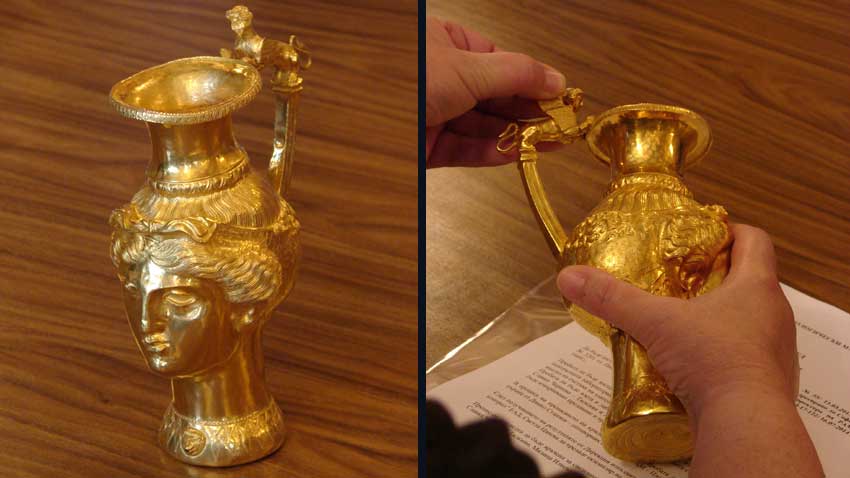One of the most famous treasures found in the Bulgarian lands, the Panagyurishte Gold Treasure, is now facing a turn in its history. It will be analyzed by the Eurotest Control Company from Austria certified under the international standards. Discovered in 1949 by the three Deykov brothers, while they were digging clay to make bricks, today the treasure represents a symbolic part of this country's Classical Antiquity heritage. It has taken part in a range of exhibitions at home and abroad. The nine magnificent gold vessels in it, an amphora, a phial and rhytons, are owned by the Archeological Museum in the City of Plovdiv. In 1974 the priceless set was moved to Sofia and today it is part of the display of the National Museum of History.
For about twenty years however, there have been a few speculations that the original treasure has been replaced with a replica. The advocates of this thesis point to certain differences in the weight of objects as the set has been weighed on several occasions.
Kostadin Kissiov, Director of the Archeological Museum in Plovdiv, explains that it is only natural to see such differences because vessels have been weighed in different times, by different people using different devices.
"This does not suggest that the Panagyurishte Treasure has been replaced,”, Mr Kissov told Radio Bulgaria. “However, a decision has been made to test the treasure, because the Director of the National Museum of History Bozhidar Dimitrov has been repeatedly accused of being reluctant to make such tests thus trying to conceal a replacement. For this reason he has decided to order chemical tests of the gold set. On this occasion I asked him to test also a wing which is a part of a rhyton under an inventory No. 3201.”

The gold wing in question was chipped off the vessel and has never left Plovdiv. Now it has arrived in Sofia to be tested.
"Based on my experience of 33 years, I should say that the gold set was not made at one go”, Kostadin Kissov continues. “Two of the vessels were made in 4th or 3rd c. BC in a different workshop than the one that produced the rest seven vessels. Their gold displays a paler tint. So, I am sure that chemical tests will show differences from the rest of the vessels. Besides, the first two vessels were targeted for the market, while the rest were commissioned by a sovereign. From this standpoint, chemical tests will fail to play down speculations about replacement because they will show definite differences. As specialists we are aware that the treasure is not homogenous. Now this wing has been in the Plovdiv museum since the treasure was found in 1949, and has been kept here by three generations of museum staff. And unlike the Panagyurishte Treasure that has traveled widely in Bulgaria and abroad to be shown in various museums, this wing has never been out of here. If a chemical test is made of this part and the vessel that it belongs to and the results are compared, it will become very clear whether there is any difference. But the restoration specialists from the National Museum of History already saw it and found out that it strictly corresponds to the place from where it was chipped off.”
Are there similar vessels to the ones in the famous set elsewhere in the world? Kostadin Kissiov explains that so far two similar vessels have been found made of gold, with the same shapes and sizes displaying however different mythological scenes and images. These are the phial and the amphora. One of the vessels was found in the town of Sinope on the Northern Black Sea coast and the other in Sicily. However as a large gold trove with these particular kinds of vessels the Panagyurishte set has no match in the world.
The results from the tests of the gold artifacts will become known by the end of the month. The final conclusion is expected in September. In 2015, the Panagyurishte Gold Treasure will be one of the highlights in a big Bulgarian exhibition in the Louvre in Paris.
English Daniela Konstantinova
Photos: Veneta NikolovaOn the second day after Easter begins Bright Week. It is so called because of the light that Christ's Resurrection brings to the world. According to Orthodox tradition, it is a time when the Holy Apostles and the Virgin Mary are glorified. Bright Week..
Patriarch Daniil celebrated a divine service for the so-called Second Resurrection of Christ in the Sofia-based church of Saint Nedelya. Patriarch Daniil greets Bulgarians with “Christ is Risen” At the festive liturgy, texts from the Gospel..
Patriarch Danil of Bulgaria, Metropolitan of Sofia, greeted the faithful with the joyful words "Christ is risen!" In his Easter message, he called on Orthodox Christians to share the extraordinary joy of heaven with the world through a life of light and..
On the second day after Easter begins Bright Week. It is so called because of the light that Christ's Resurrection brings to the world. According to..

+359 2 9336 661
